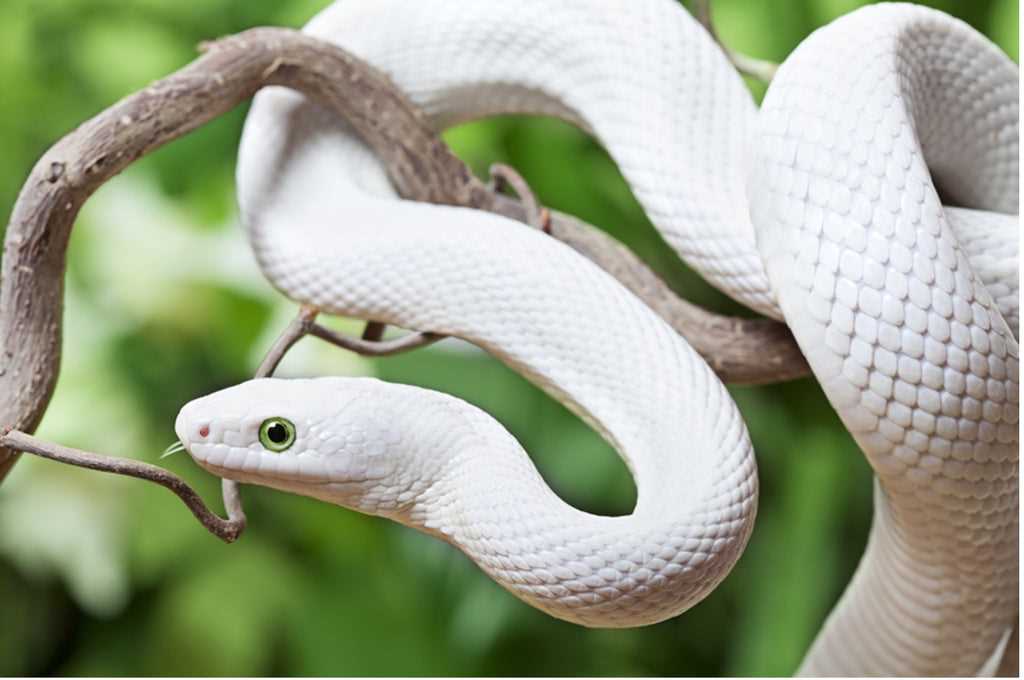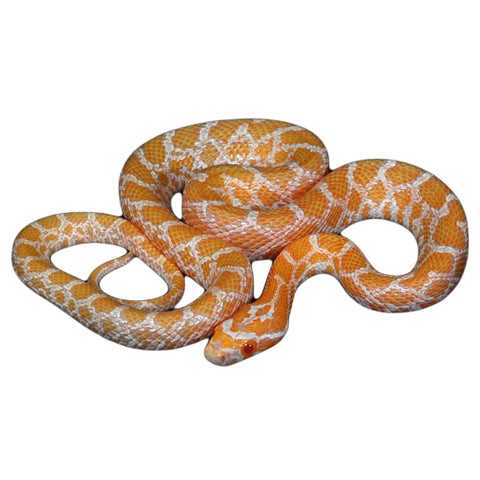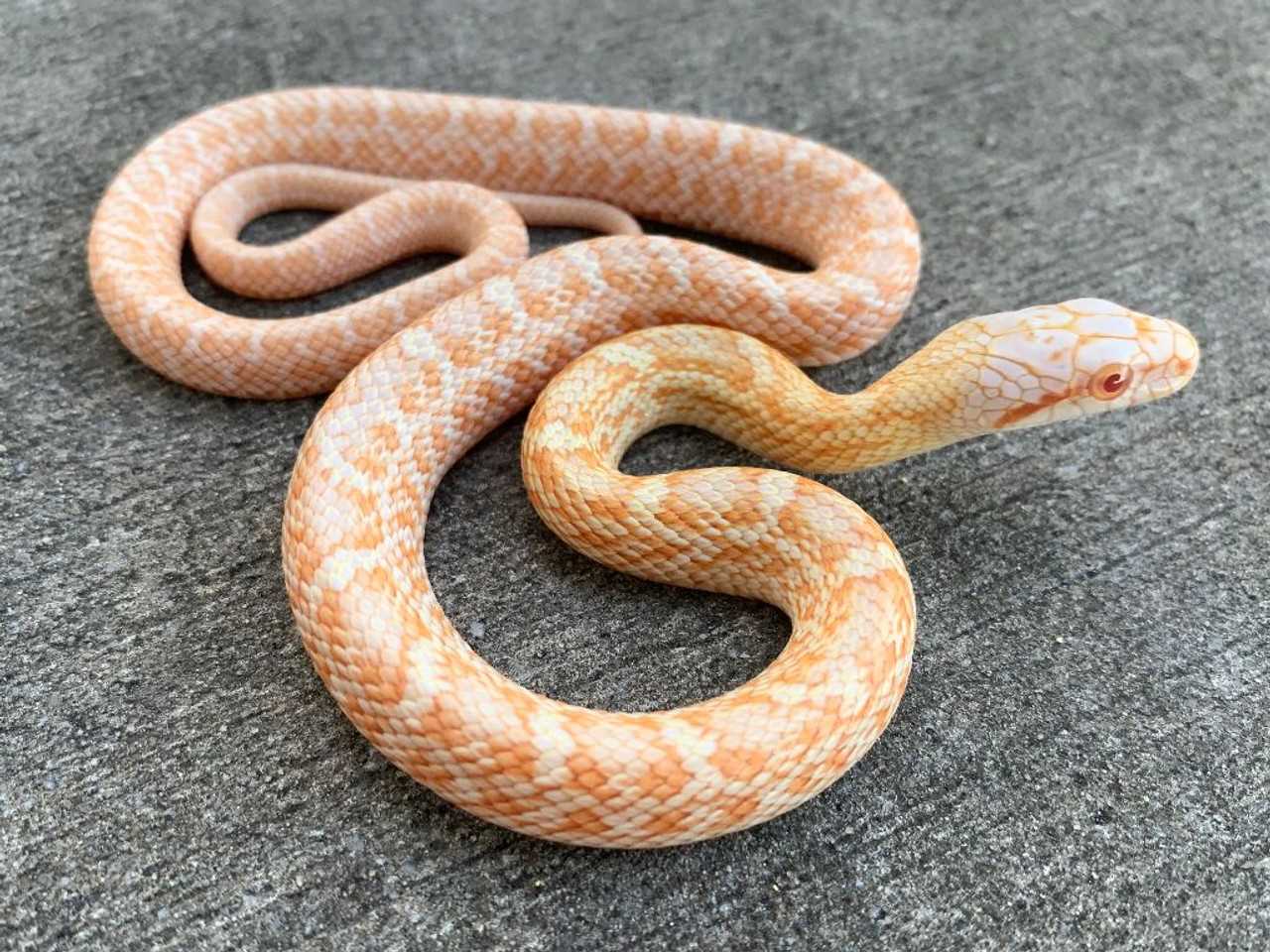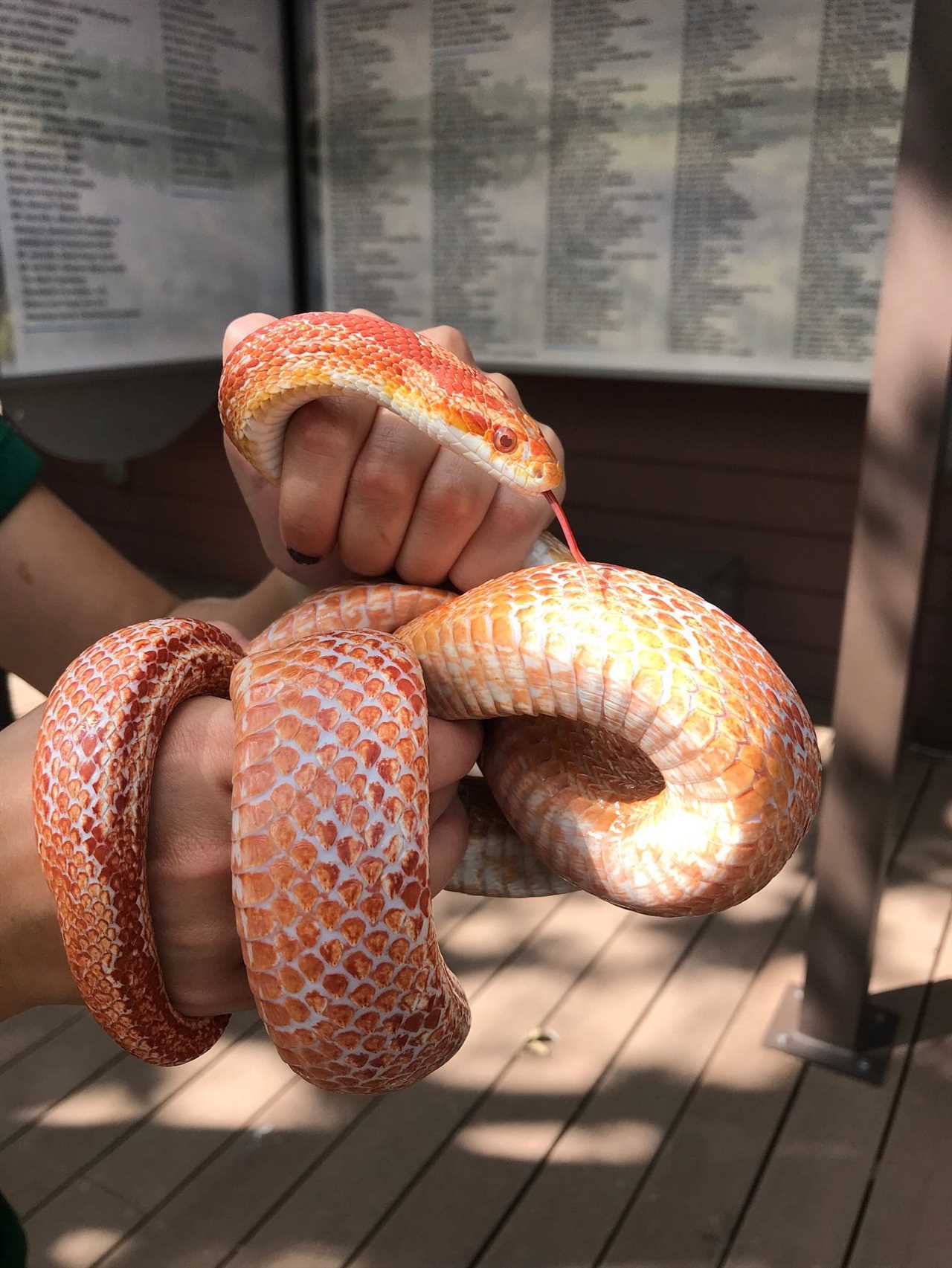
The albino rat snake is a captivating creature with its striking white scales and mesmerizing patterns. This snake is a favorite among reptile enthusiasts and often kept as pets due to its docile nature and stunning appearance.
While the albino rat snake may look delicate, it is a formidable predator in its own right. With its slender body, powerful muscles, and sharp teeth, it is more than capable of subduing and consuming its prey. Despite its predatory nature, the albino rat snake can be easily tamed through captive breeding, making it a popular choice for snake enthusiasts as an exotic and unique pet.
The Albino Rat Snake: A Rare Species
The albino rat snake is a unique and fascinating reptile that is highly sought after as a pet. With its striking white coloration and captivating pattern, this snake is a favorite among snake enthusiasts and collectors.
As its name suggests, the albino rat snake is a type of rat snake that lacks pigmentation, resulting in its distinct white appearance. This lack of pigment is due to a genetic mutation that affects the production of melanin, the pigment responsible for skin, hair, and eye color in animals.
Unlike some other albino animals, the albino rat snake is not an entirely white snake. It typically has faint yellow or cream-colored scales along its body, giving it a subtle but charming appearance.
In the wild, the albino rat snake is primarily found in North America, specifically in the southeastern United States. It inhabits a variety of habitats, including forests, grasslands, and marshes. The snake is a skilled predator and feeds primarily on small rodents, such as rats and mice. Its ability to consume prey much larger than itself is facilitated by its flexible jaws and expandable stomach.
Habitat and Geographic Distribution
Habitat
The albino rat snake is native to a wide range of habitats, including forests, grasslands, and rocky areas. They are found in various regions across North America, including the United States and Canada. These snakes are adaptable and can thrive in different environments, which is one reason for their widespread distribution.
Geographic Distribution
The albino rat snake can be found in several states in the southeastern and central parts of the United States, including Texas, Oklahoma, Mississippi, and Arkansas. They have also been spotted in parts of Mexico and southern Canada. These snakes prefer wooded areas with plenty of hiding spots and access to prey, such as rodents.
| Common Name | Scientific Name | Geographic Distribution |
|---|---|---|
| Albino Rat Snake | Pantherophis guttatus | United States, Mexico, Canada, introduced in other regions |
Overall, the albino rat snake is an intriguing reptile that has captured the fascination of snake enthusiasts and pet owners alike. Its unique white scales and adaptability make it a remarkable species to study and admire.
Physical Characteristics of the Albino Rat Snake
The albino rat snake has a slender and elongated body, typically growing to between 3 to 6 feet in length. Its body is covered in overlapping scales that provide protection from predators and environmental conditions. These scales also allow the snake to move smoothly across various surfaces without any friction.
The albino rat snake is also known for its exceptional ability to camouflage. It can blend in with its surroundings, thanks to its white coloration, making it difficult for predators to spot it. This adaptation provides the snake with a significant advantage when hunting or avoiding potential threats.
Behavior and Diet

The albino rat snake is a constrictor, meaning it kills its prey by suffocating it. It has a strong grip and can wrap its body around its prey tightly, preventing it from breathing. This snake mainly feeds on small mammals, such as rats and mice, hence its name “rat snake.” However, it may also eat birds, eggs, and occasionally even other snakes.
As with any pet, the albino rat snake may experience common health issues and concerns. These can include respiratory infections, parasitic infestations, and shedding difficulties. Regular veterinary check-ups and proper hygiene can help prevent and address these issues.
Reproduction and Life Cycle of the Albino Rat Snake
Sexual Maturity and Breeding
The albino rat snake reaches sexual maturity at around 2 to 3 years of age. During the breeding season, which typically occurs in the spring, males actively search for females by following their scent trails. Once a male locates a receptive female, he will undergo a courtship ritual that involves rubbing against the female’s body and intertwining their tails.
Egg Laying and Incubation
After successful mating, the female albino rat snake will lay eggs within 2 to 4 weeks. The average clutch size ranges from 5 to 25 eggs, depending on the size and condition of the female. These eggs are usually soft and leathery in texture.
Once the eggs are laid, it is crucial to provide the proper incubation conditions for their development. The eggs should be carefully collected and placed in a suitable incubator, with temperatures ranging between 82°F and 86°F (28°C and 30°C). The eggs will take approximately 45 to 60 days to hatch, with the exact duration depending on the incubation temperature.
Hatching and Juvenile Stage
When the albino rat snake eggs start to hatch, the baby snakes emerge with a small egg tooth, which they use to break the shell. The hatchlings are usually around 12 to 18 inches (30 to 46 centimeters) long and have a vibrant white coloration, like their adult counterparts.
| Reproduction and Life Cycle | |
|---|---|
| Sexual Maturity | 2 to 3 years |
| Breeding Season | Spring |
| Average Clutch Size | 5 to 25 eggs |
| Incubation Period | 45 to 60 days |
| Juvenile Length | 12 to 18 inches (30 to 46 centimeters) |
The Albino Rat Snake as a Pet
Feeding the albino rat snake is another important aspect of its care. As a carnivorous reptile, its diet primarily consists of small rodents such as mice and rats. It is crucial to provide the snake with appropriately sized prey to prevent choking or other digestive issues. Feeding should take place in a separate container to avoid any potential aggression or stress during mealtime.
Overall, the albino rat snake can make a fascinating and rewarding pet for those who are willing to put in the time and effort to meet its specific needs. It is crucial to research and educate yourself about this species before becoming a pet owner, to ensure the best possible care for the snake. With the right knowledge and dedication, owning an albino rat snake can be a truly unique and fulfilling experience.
Proper Care and Enclosure Requirements

When keeping an albino rat snake as a pet, it is crucial to provide proper care and ensure the right enclosure requirements. Creating a suitable environment will help your pet snake thrive and stay healthy.
The size of the enclosure is an essential factor to consider. A rat snake needs enough space to move around and stretch out. A minimum enclosure size is usually recommended, with a length of at least 6 feet (1.8 meters). However, providing a larger space, such as an 8-foot (2.4 meters) enclosure, is even better.
The enclosure should be escape-proof, as albino rat snakes are excellent escape artists. Make sure to use a secure enclosure with locks or latches on all openings.
The substrate, or bedding, in the enclosure should be appropriate for the snake’s needs. A variety of options can be used, including aspen shavings, cypress mulch, or reptile carpet. Avoid using substrates that can cause harm, such as cedar, pine, or sand.
Temperature and humidity levels are crucial for the well-being of your albino rat snake. A temperature gradient should be provided, with a hot spot of around 85-90°F (29-32°C) on one side of the enclosure and a cooler side of around 75-80°F (24-27°C) on the other. This gradient allows the snake to regulate its body temperature as needed. Use heat bulbs, heating pads, or ceramic heat emitters to maintain the appropriate temperature.
The humidity within the enclosure should be regulated as well. Maintain a humidity level of around 50-60% for albino rat snakes. This can be achieved by misting the enclosure with water, using a humidifier, or providing a moist hide box.
Decorations and hiding spots are essential for the snake’s well-being. Provide branches, rocks, and plants for climbing and exploring. Additionally, offer a few hiding spots, such as reptile caves or hollow logs. These hiding spots will make your pet feel secure and help reduce stress levels.
Feeding your albino rat snake a proper diet is crucial for its overall health. As a carnivorous predator, the snake’s diet consists of rodents. Frozen and thawed prey, such as mice or rats, are recommended for feeding. The size of the prey should be appropriate for your snake’s size, typically around 1.5 times the snake’s girth. Feed your snake once every 1-2 weeks, depending on its age and size.
Regularly clean and disinfect the enclosure to ensure a clean and hygienic environment for your pet. Remove any waste, uneaten food, and shed skin promptly. Perform a thorough cleaning and disinfection at least once a month.
Monitoring your albino rat snake’s health is essential. Regularly check for any signs of illness, such as changes in appearance, appetite, or behavior. If you notice any issues, consult with a reptile veterinarian to ensure proper diagnosis and treatment.
By providing the correct care and following these enclosure requirements, you can create a suitable and comfortable habitat for your albino rat snake.
Feeding and Nutrition
Rat snakes are carnivorous, which means they primarily feed on rats and mice in the wild. As a captive snake, it is best to feed them appropriately sized rodents that are pre-killed or frozen and thawed. This ensures the safety of both the pet and the owner.
The size of the prey should be proportional to the size of the snake. Hatchlings and young snakes can be fed pinky mice or rat pups, while adult snakes can consume larger prey, such as adult mice or rats. It is crucial to avoid feeding live prey as it can cause injuries to the snake during feeding.
Regular feeding schedule is paramount to maintaining a healthy rat snake. They should be fed every 7-10 days, depending on their age and size. Younger snakes may require more frequent feedings to support their growth, while adult snakes can be fed less frequently.
Proper hydration is also crucial for the well-being of albino rat snakes. A shallow dish of fresh water should be provided at all times, and it should be cleaned and refilled regularly. This ensures that the snake has access to clean drinking water and helps maintain proper hydration.
Common Health Issues and Concerns
Additionally, albino rat snakes may be prone to parasites, such as mites or ticks. These external parasites can cause irritation and discomfort for the snake. Regular health check-ups and proper care can help prevent infestations and ensure the snake’s well-being.
It is also important to consider the albino rat snake’s diet and nutrition. These snakes are carnivorous and feed primarily on rodents in the wild. As a pet owner, it is crucial to provide them with a balanced diet that includes appropriately-sized prey. Feeding snakes the wrong size or type of prey can lead to malnutrition or obesity.
Conservation Status and Threats
The conservation status of the albino rat snake is currently not assessed separately from the normal rat snake species. However, the general population of rat snakes is considered to be of least concern by the International Union for Conservation of Nature (IUCN).
Despite the overall healthy population status, there are some threats that the albino rat snake and other snake species face in their natural habitats. One of the main threats is habitat loss and fragmentation due to human activities such as deforestation and urbanization. These activities result in the destruction and degradation of the snake’s habitat, limiting their availability of suitable nesting sites and food sources.
Poaching for the pet trade is another significant threat to the albino rat snake, especially due to its unique albino coloration. The demand for albino reptiles, such as snakes, as pets is high, leading to illegal collection and trade of these animals. Unregulated pet trade can have detrimental impacts on wild snake populations, as it can lead to overexploitation and unsustainable harvest.
To address these threats and ensure the long-term conservation of the albino rat snake, several measures can be taken. First, it is essential to create and enforce protected areas and conservation reserves that specifically include the habitats of these snakes. These protected areas can help conserve the snake populations by preserving their natural habitats and minimizing human disturbances.
Additionally, public awareness and education campaigns about the importance of snakes and their role in maintaining ecosystem balance can help reduce the negative perceptions and stereotypes associated with these reptiles. These campaigns can also discourage the illegal trade of albino rat snakes and promote responsible pet ownership.
Furthermore, research and monitoring programs should be conducted to gather more information about the population size and trends of albino rat snakes. This data can help determine the effectiveness of conservation efforts and inform future management strategies.
| Threats to Albino Rat Snakes | Conservation Measures |
|---|---|
| Habitat loss and fragmentation | Creation of protected areas, habitat restoration |
| Poaching for the pet trade | Enforcement of laws, public awareness campaigns |
| Invasive species | Management and control programs |
Interesting Facts about the Albino Rat Snake

The albino rat snake is a fascinating reptile known for its unique appearance and behavior. Here are some interesting facts about this captivating snake:
| Fact 1 | |
| Fact 2 | Unlike its wild counterparts, albino rat snakes are primarily found in captivity and are popular pets among reptile enthusiasts. Their striking white color makes them stand out in any collection. |
| Fact 3 | Albino rat snakes are non-venomous and belong to the family Colubridae. Despite their white color, they are excellent predators and feed on a variety of prey, including small mammals, birds, and eggs. |
| Fact 4 | These snakes have a slender body and can grow up to 6 feet in length. They have smooth scales and a pointed head, characteristics that help them navigate through their habitat and capture their prey. |
| Fact 5 | |
| Fact 6 | These snakes reproduce through internal fertilization and lay eggs, with an average clutch size of 10-20 eggs. The eggs are typically laid in secluded areas, such as under rocks or in decaying logs. |
| Fact 7 | Albino rat snakes have a relatively long lifespan, with some individuals living up to 20 years in captivity. Providing them with a proper diet, adequate habitat, and regular veterinary care is essential for their well-being and longevity. |
| Fact 8 | These snakes are not only beautiful but also play an important role in their ecosystem as predators. By controlling populations of small mammals and birds, they help maintain the balance of the food chain in their native habitats. |
Overall, the albino rat snake is a captivating and unique reptile that has become a popular pet among reptile enthusiasts. Its striking white appearance, along with its docile nature, makes it a prized addition to any reptile collection.
Similar Species and Subspecies
The albino rat snake, with its striking white coloration, is often confused with other similar species and subspecies of rat snakes. While they may look similar at first glance, there are several key differences in their appearance and behavior that set them apart.
One of the most commonly mistaken species is the white-lipped snake (Dryophis albiventris). Both snakes have a white coloration, but the albino rat snake is larger and has a more robust body. The white-lipped snake also lacks the distinctive red eyes that are characteristic of the albino rat snake.
Another closely related subspecies is the albino corn snake (Pantherophis guttatus). While the albino corn snake and the albino rat snake share similar coloration and patterns, they have different habitats and geographic distributions. The albino corn snake is often found in the southeastern United States, while the albino rat snake is native to parts of Asia and Africa.
It is also worth noting that the albino rat snake is often mistaken for the white snake (Leucistic snake), which has a similar lack of pigmentation. However, leucistic snakes have blue eyes, as opposed to the red eyes of the albino rat snake.
Despite these similarities and mistaken identities, the albino rat snake remains a unique and sought-after pet snake among reptile enthusiasts. Its striking white coloration, combined with its docile nature and manageable size, make it a popular choice for those looking to keep a captivating and captivating pet snake.
Famous Albino Rat Snakes in History
The Albino Rat Snake is a popular and sought-after pet snake due to its unique and striking appearance. Over the years, several famous Albino Rat Snakes have captured the attention of reptile enthusiasts and the general public alike.
One of the most famous Albino Rat Snakes in history is “Lucy.” Lucy gained worldwide fame when her owner, John Smith, showcased her on various television shows and reptile exhibitions. Lucy’s striking white scales and ruby-red eyes made her a favorite among the audience, and she quickly became a symbol of the beauty and uniqueness of Albino Rat Snakes.
Another notable Albino Rat Snake is “Spike.” Spike was owned by renowned herpetologist Dr. Sarah Thompson. With his large size and impressive hunting skills, Spike became a popular attraction at the reptile and snake exhibits hosted by Dr. Thompson. People marveled at Spike’s ability to strike with precision and efficiently capture prey, showcasing the predatory nature of these captivating reptiles.
“Snowflake” is another Albino Rat Snake that gained recognition for her stunning appearance. Snowflake’s owner, Jane Williams, used her as an ambassador for snake conservation. Together, they visited schools and educational institutions to teach students about the importance of preserving snake species and their habitats. Snowflake’s gentle temperament and docile nature proved that snakes, even ones with a reputation for being deadly, can be captivating pets and ambassadors for their species.
The fame of these famous Albino Rat Snakes highlights the allure of keeping these reptiles as pets. Their remarkable coloration and captivating behavior make them popular among reptile enthusiasts and collectors. Additionally, these famous Albino Rat Snakes have played a crucial role in raising awareness about snake conservation and dispelling misconceptions about these fascinating creatures.
| Snake Name | Owner | Notable Features |
|---|---|---|
| Lucy | John Smith | Striking white scales and ruby-red eyes |
| Spike | Dr. Sarah Thompson | Impressive hunting skills and large size |
| Snowflake | Jane Williams | Used as an ambassador for snake conservation |
These famous Albino Rat Snakes have left a lasting impact on the world of herpetology and snake enthusiasts. Through their unique appearances and the stories of their owners, they have helped to educate and inspire others about the beauty and importance of these reptiles.
How to Get Involved in Albino Rat Snake Conservation

1. Join a Conservation Organization
One of the most effective ways to get involved is by joining a conservation organization that focuses on reptiles. These organizations often work to preserve the natural habitats of endangered species, including the albino rat snake. By becoming a member, you can support their research and conservation efforts.
2. Volunteer at a Reptile Rescue Center
Another way to make a difference is by volunteering at a reptile rescue center. These centers provide care and rehabilitation to reptiles that have been injured or abandoned. By volunteering your time and skills, you can help ensure that these snakes receive the proper care they need to recover and potentially be released back into the wild.
3. Support Legislation and Policies
Supporting legislation and policies that protect reptiles and their habitats is another crucial step in conservation. Stay informed about local and national laws related to reptile protection and advocate for stronger regulations if needed. By voicing your concerns and spreading awareness, you can help create a safer environment for these animals.
4. Educate Others
One of the most impactful ways to contribute to conservation efforts is by educating others about the importance of reptile conservation. Spread the word about the albino rat snake’s unique characteristics, its role in the ecosystem, and the threats it faces. By raising awareness, you can inspire others to take action and make a difference.
5. Support Captive Breeding Programs
As albino rat snakes are often kept as pets, supporting captive breeding programs can play a significant role in conservation. Instead of purchasing wild-caught specimens, consider adopting or purchasing captive-bred individuals. This helps reduce the demand for wild-caught snakes and supports the sustainable breeding of healthy populations.
